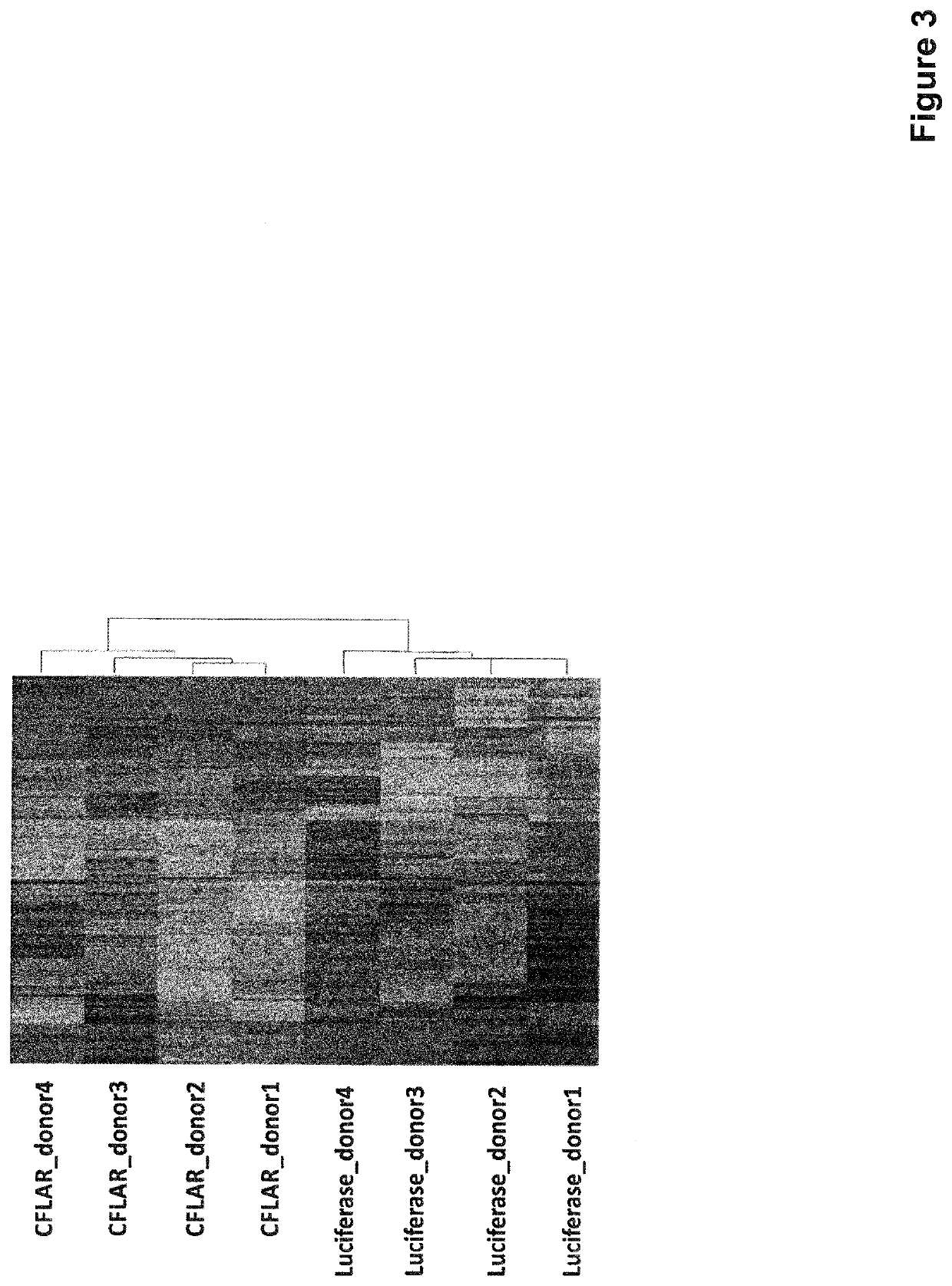Engineered Cells for Inducing Tolerance
a technology of inducing tolerance and engineering cells, which is applied in the field of inducing tolerance of engineered cells, can solve the problems of slowing down the mdsc-enumeration in the clinical routine, affecting so as to prolong the survival rate of foreign grafts, enhance the tolerogenic or immunosuppressive potential of cells, and increase the immunosuppressive activity
- Summary
- Abstract
- Description
- Claims
- Application Information
AI Technical Summary
Benefits of technology
Problems solved by technology
Method used
Image
Examples
example 2
ced CFLAR Expression on Monocytes Drives a MDSC-Like Molecular Program that Control the Immunosuppressive Function
[0227]To identify better the CFLAR-activated molecular pathway underlying the immunosuppressive functional program in myeloid cells, we performed a transcriptome analysis of CFLAR- and luciferase-infected CD14+ cells isolated from four healthy donors. Briefly, total RNA was isolated using TRIzol reagent (Life technology, CA, U.S.A.) and RNA integrity assessed using Agilent-2100-Bioanalyzer (Agilent Technologies, CA, U.S.A.). The RNA was further purified with RNeasy MinElute Cleanup kit (Qiagen, Venlo, Netherlands) and cDNA was synthesized and amplified from total purified RNA with Ovation Pico WTA System V2 (NuGEN, CA, U.S.A.). All the samples were hybridized to Affymetrix U133 PLUS 2.0 arrays and scanned with an Affymetrix GCS 3000 7G scanner. Sample and genes are clustered using Pearson correlation coefficient and average as distance metric and linkage, respectively. A...
example 3
ive Transfer of CFLAR-Expressing Monocytes Controls the Progression of GvHD in Immunodeficient Mice Transplanted with Human PBMCs
[0228]On the basis of these observations, we decided to assess in vivo the immune suppressive functions of CFLAR-infected CD14+ cells (as previously described) to control the development of graft versus host disease (GvHD) using a xenogeneic mouse model. For this purpose, we intravenously (i.v.) injected sub-lethally irradiated (using 137Cs-source irradiator), immunodeficient NOD.Cg-Prkdcscid Il2rgtm1Sug / JicTac (NOG) (purchased by Taconic, NY, U.S.A.) mice with 106 human PBMCs isolated from buffy coats. When the frequency of circulating human CD3+ lymphocytes reached a percentage ˜5% of total cells, we started treating the mice by i.v. transfer of 106 CFLAR- or luciferase-expressing monocytes. Briefly by retro orbital bleeding we isolated 100 μl of blood; red-cells were eliminated by ACK (Ammonium-Chloride-Potassium) Lysing Buffer and cells were stained wi...
example 4
LIP; LysMcre Mouse Model
[0230]In order to understand better the CFLAR-induced molecular pathway, we took advantage of a transgenic mouse model expressing the viral form of CFLAR: the Rosa26.vFLIP knock-in mice. The Kaposi's sarcoma-associated herpesvirus encodes a FADD-like interferon converting enzyme or caspase 8 (FLICE) inhibitory protein (vFLIP) in its genome. The Rosa26.vFLIP knock-in mice were bred with mice expressing the Cre recombinase under the control of the endogenous Lyz2 promoter (LysM-Cre), thus resulting in mice with vFLIP expression restricted to the myeloid cell lineage. Bone marrow cells and splenocytes were obtained from both Rosa26.vFLIP; LysMcre and Rosa26.vFLIP mice and we isolated by fluorescence-activated cell sorting (FACS) the CD11B+ Ly6G− Ly6Chigh and the CD11B+ Ly6G+ Ly6Clow subsets. The immunosuppressive activity of these cells was then evaluated plating the freshly isolated myeloid cells in 96 wells plate at a final concentration of 24% of total cells ...
PUM
| Property | Measurement | Unit |
|---|---|---|
| Composition | aaaaa | aaaaa |
| Level | aaaaa | aaaaa |
Abstract
Description
Claims
Application Information
 Login to View More
Login to View More - R&D
- Intellectual Property
- Life Sciences
- Materials
- Tech Scout
- Unparalleled Data Quality
- Higher Quality Content
- 60% Fewer Hallucinations
Browse by: Latest US Patents, China's latest patents, Technical Efficacy Thesaurus, Application Domain, Technology Topic, Popular Technical Reports.
© 2025 PatSnap. All rights reserved.Legal|Privacy policy|Modern Slavery Act Transparency Statement|Sitemap|About US| Contact US: help@patsnap.com



